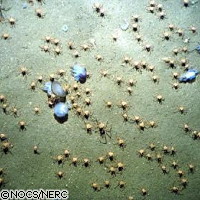Life in minimum-oxygen ocean zones at risk
Even areas of the deep ocean with very low oxygen concentrations can be awash with life. However, these habitats are threatened by global climate change, as it has the potential to cause further oxygen depletion. New research, published in the journal Marine Ecology, analysed biodiversity in oxygen-minimum zones (OMZs) in the Arabian Sea, eastern Pacific and Bay of Bengal. The study was supported by the EU-funded HERMIONE ('Hotspot ecosystem research and man's impact on European seas') project, part of the Environment Theme of the Seventh Framework Programme (FP7). HERMIONE has received EUR 8 million in financial support. OMZs are mid-water areas in the ocean where oxygen saturation is at its lowest. They are created by the degradation of organic matter from the upper water levels, which are rich in oxygen. Tiny marine algae (phytoplankton) populate these levels. As they die and slowly sink to the ocean floor, aerobic bacteria feed on them and degrade the matter, using up oxygen. Due to lack of mixing of the water column (a conceptual column of water from surface to bottom sediments), these low-oxygen areas are not replenished with oxygen, leading to the creation of OMZs at depths between 100 and 1,000 metres. The core regions of OMZs tend to be rather stable, although seasonal or longer-term climatic changes may cause shifts in their upper boundaries and hence community composition. Sediments in these zones will still contain large amounts of organic matter. As a result, they are the ideal habitats for certain microorganisms and species of animals that can tolerate low levels of oxygen. 'Oxygen seems to be the overriding factor controlling biological diversity and seabed community composition within OMZ core regions,' said the lead author of the study, Professor Andrew Gooday of the National Oceanographic Centre (NOC) in Southampton, UK. 'Where oxygen levels increase, the strong seafloor gradients create variety that exerts an increasingly important influence, with different habitat types supporting different kinds of organisms. In particular, the lower boundaries of OMZs, where oxygen levels begin to rise and food is plentiful, often teem with large organisms, among them brittle stars and spider crabs.' NOC's Dr Brian Bett added, 'The skeletons and carcasses of marine animals provide discrete habitats where other creatures can thrive. For example, scavengers such as shrimp-like crustaceans exploit accumulations of dead jellyfish, fish and crabs, while other species live off whale bones.' The extreme conditions in OMZs increase environmental variety of species, as low oxygen concentration will promote adaptations including smaller body sizes and larger body surface, which enhance oxygen intake. Professor Gooday explained: 'OMZs may be a cradle of biological diversity, promoting speciation by creating strong gradients in the environmental conditions that are important for species as well as barriers to population exchange.' However, global warming is a considerable threat to these habitats: as ocean temperature rises, vertical water mixing is expected to decrease just as oxygen solubility in seawater. When oxygen depletion grows too severe, animals and organisms start disappearing. 'If this [global warming] results in larger, more intense OMZs, the impact on biodiversity is likely to be negative,' Dr Brett reiterated. HERMIONE is dedicated to furthering our understanding of deep-sea ecosystems and their contribution to the production of goods and services. The large-scale project brings together 38 partners from 13 European and 1 African nations.
Countries
United Kingdom



